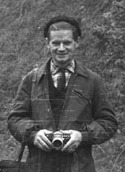André Leroi-Gourhan facts for kids
Quick facts for kids
André Leroi-Gourhan
|
|
|---|---|

Leroi-Gourhan in 1966
|
|
| Born | 25 August 1911 Paris, France
|
| Died | 19 February 1986 (aged 74) Paris, France
|
| Nationality | French |
| Occupation | Archeologist |
| Known for | Technical tendencies |
| Spouse(s) | Arlette Leroi-Gourhan |
André Leroi-Gourhan (born August 25, 1911 – died February 19, 1986) was a famous French scientist. He was an archeologist, paleontologist, and anthropologist. This means he studied ancient human history, fossils, and human cultures. He was very interested in how humans used technology and created art. He also liked to think deeply about these topics.
Contents
About André Leroi-Gourhan
His Early Life and Studies
André Leroi-Gourhan was born in Paris, France. He studied the ancient history of the North Pacific region. His main teacher was a well-known scientist named Marcel Mauss.
Working in Museums and the War
Starting in 1933, Leroi-Gourhan worked at many museums around the world. These included the British Museum in London and the Musée de l'Homme in Paris. He also worked in Japan.
During World War II, from 1940 to 1944, he worked at the Musée Guimet. In 1944, he was sent to a castle called Château de Valençay. His job there was to protect important artworks from the Louvre museum. These famous pieces included the Venus de Milo statue and the Winged Victory of Samothrace.
Leroi-Gourhan also bravely joined the French Resistance. This was a secret group fighting against the occupation of France. For his courage, he received several important awards. These included the Croix de Guerre and the Légion d'honneur.
Teaching and Later Years
In 1956, he became a professor at the Sorbonne, a famous university. Later, from 1969 to 1982, he taught at the Collège de France. In 1973, he received a special gold medal from the French National Center for Scientific Research. This was a very high honor for his scientific work.
How Humans Use Technology
Understanding Technical Tendencies
Leroi-Gourhan wrote a book called L'Homme et la matière, which means Man and Matter. In this book, he talked about "technical tendencies." These are like universal ways that technology develops. They happen no matter what specific group of people is using them. However, these tendencies always show up in unique ways within different cultures. He called these unique ways "technical facts."
Environment and Techniques
In another book, Milieu et techniques (Environment and Techniques), he explained more about how technology and culture connect. He believed that human groups act like living things. They use technology to interact with their surroundings. He called this technology an "artificial envelope" or a "curtain of objects."
He divided the surroundings into two parts:
- The outside environment: This includes things like geography, climate, animals, and plants.
- The inside environment: This is the shared history and culture of a group.
A "technical tendency" is a movement within a group's culture that slowly becomes part of how they deal with their outside world.
The "Operational Chain"
Leroi-Gourhan also helped improve how we study ancient technology. He introduced the idea of the "chaîne opératoire" (pronounced "shen op-er-a-twahr"). This means the "operational chain." It describes all the steps and social actions involved in making and using an artifact. For example, it includes finding the raw material, shaping it, using it, and even throwing it away.
Evolution, Memory, and Programs
Leroi-Gourhan had an interesting idea about human evolution. He thought that when humans started walking on two feet (called bipedality), it freed up their hands. This allowed them to use tools. It also freed up their faces for gesturing and speaking.
He believed that the development of the human brain, technology, and language all came from standing upright. What makes humans different from animals, he said, is that tools and technology are like a third type of memory.
- First memory: Our DNA (genetic memory).
- Second memory: Our nervous system (individual memory).
- Third memory: Tools and technology.
This "third memory" helps us plan for the future, like a program. So, for Leroi-Gourhan, the development of humans (anthropogenesis) is closely linked to the development of technology (technogenesis).
Images for kids
-
Leroi-Gourhan, with fellow archaeologists, outside the Altxerri cave
See also
 In Spanish: André Leroi-Gourhan para niños
In Spanish: André Leroi-Gourhan para niños


